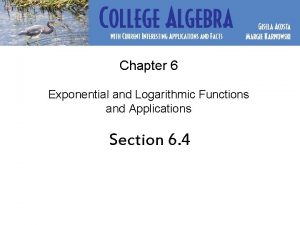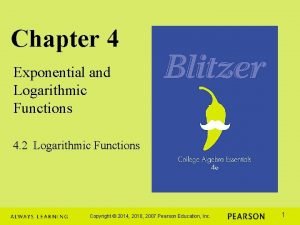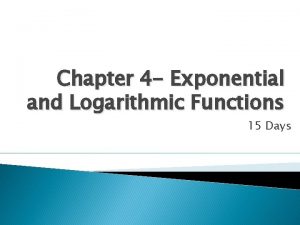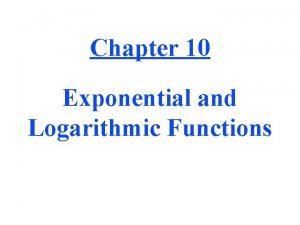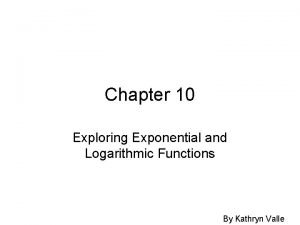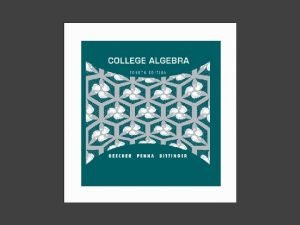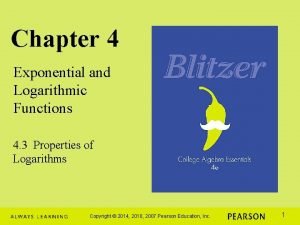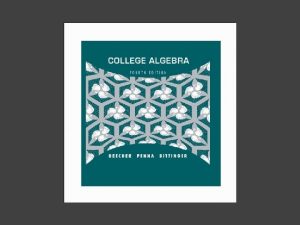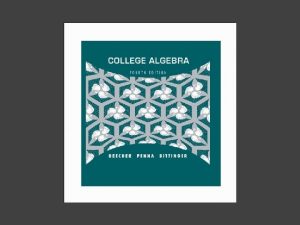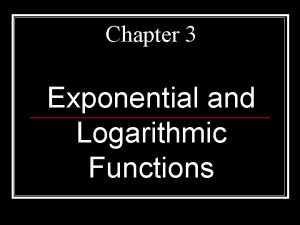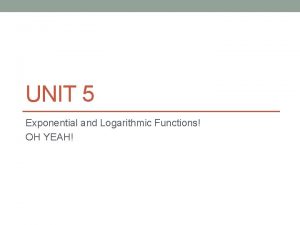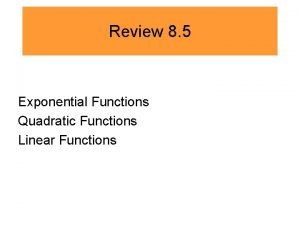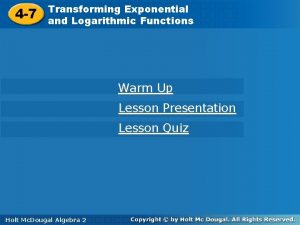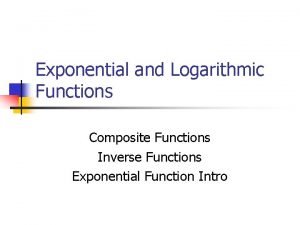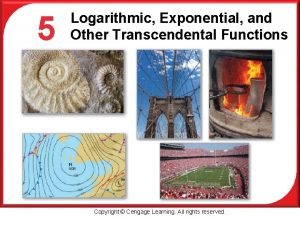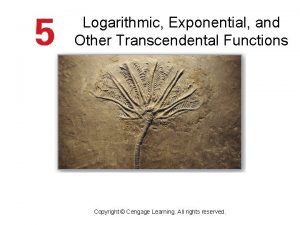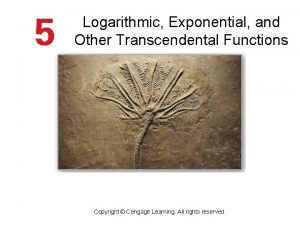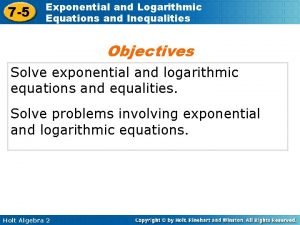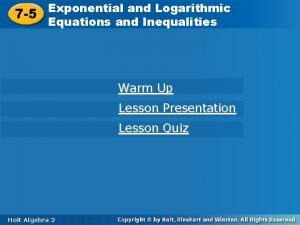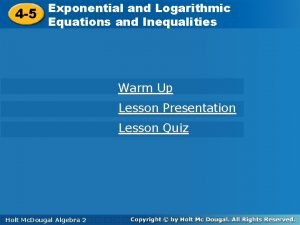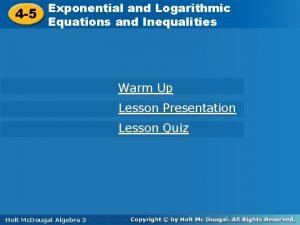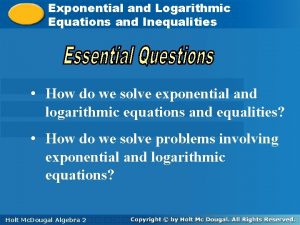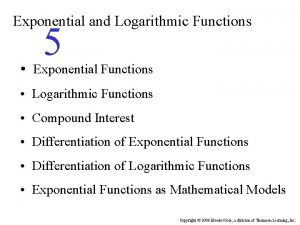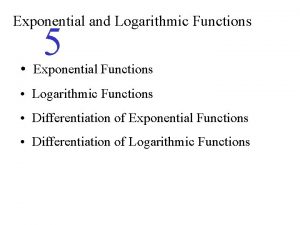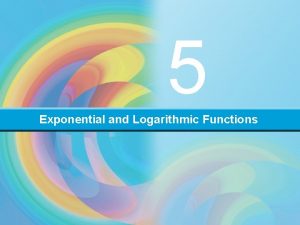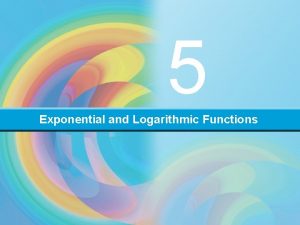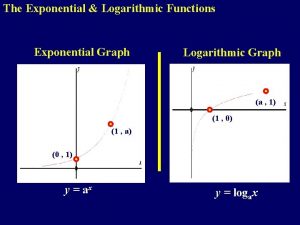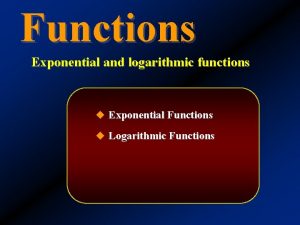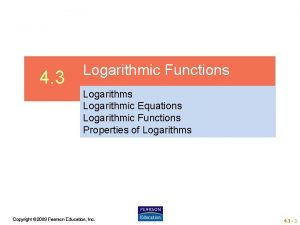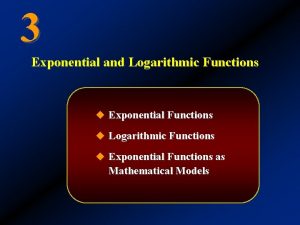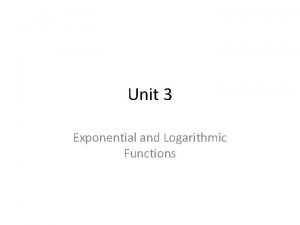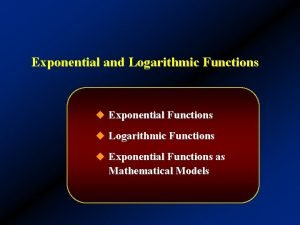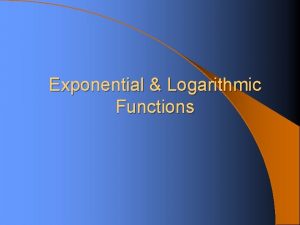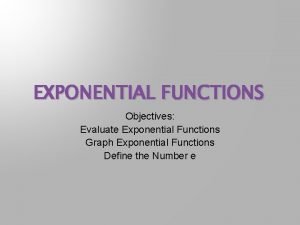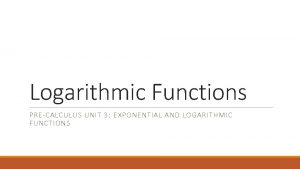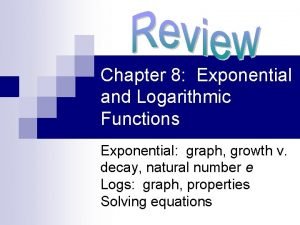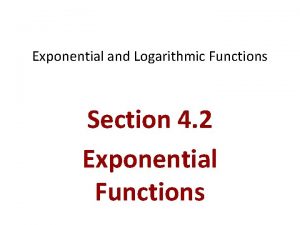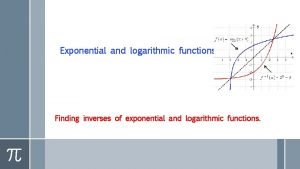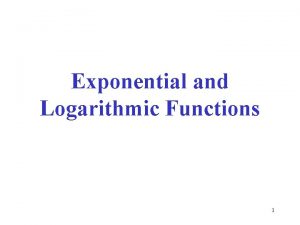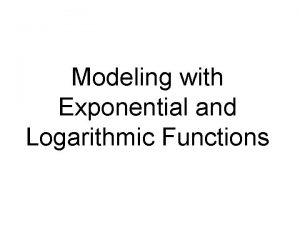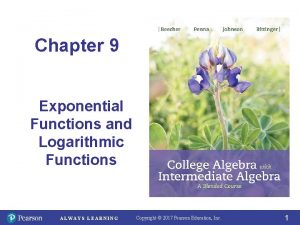Chapter 4 Exponential and Logarithmic Functions 4 2

























- Slides: 25

Chapter 4 Exponential and Logarithmic Functions 4. 2 Logarithmic Functions Copyright © 2014, 2010, 2007 Pearson Education, Inc. 1

Objectives: • • Change from logarithmic to exponential form. Change from exponential to logarithmic form. Evaluate logarithms. Use basic logarithmic properties. Graph logarithmic functions. Find the domain of a logarithmic function. Use common logarithms. Use natural logarithms. Copyright © 2014, 2010, 2007 Pearson Education, Inc. 2

Definition of the Logarithmic Function For x > 0 and b > 0, b 1, y = logbx is equivalent to by = x. The function f(x) = logbx is the logarithmic function with base b. Copyright © 2014, 2010, 2007 Pearson Education, Inc. 3

Example: Changing from Logarithmic to Exponential Form Write each equation in its equivalent exponential form: means Copyright © 2014, 2010, 2007 Pearson Education, Inc. 4

Example: Changing from Exponential to Logarithmic Form Write each equation in its equivalent logarithmic form: means Copyright © 2014, 2010, 2007 Pearson Education, Inc. 5

Example: Evaluating Logarithms Evaluate: means 10 to what power gives 100? because 102 = 100 Evaluate: means 5 to what power gives because Copyright © 2014, 2010, 2007 Pearson Education, Inc. 6

Example: Evaluating Logarithms Evaluate: means 36 to what power gives 6? because Copyright © 2014, 2010, 2007 Pearson Education, Inc. 7

Example: Evaluating Logarithms Evaluate: means 3 to what power gives because Copyright © 2014, 2010, 2007 Pearson Education, Inc. 8

Basic Logarithmic Properties Involving One 1. logbb = 1 because 1 is the exponent to which b must be raised to obtain b. (b 1 = b) 2. logb 1 = 0 because 0 is the exponent to which b must be raised to obtain 1. (b 0 = 1) Copyright © 2014, 2010, 2007 Pearson Education, Inc. 9

Example: Using Properties of Logarithms Evaluate: log 99 Because logbb = 1, we conclude log 99 = 1. Evaluate: log 81 Because logb 1 = 0, we conclude log 81 = 0. Copyright © 2014, 2010, 2007 Pearson Education, Inc. 10

Inverse Properties of Logarithms For b > 0 and b 1, Copyright © 2014, 2010, 2007 Pearson Education, Inc. 11

Example: Using Inverse Properties of Logarithms Evaluate: Because we conclude Copyright © 2014, 2010, 2007 Pearson Education, Inc. 12

Example: Graphs of Exponential and Logarithmic Functions Graph and rectangular coordinate system. We first set up a table of coordinates for in the same x – 2 – 1 We will reverse these coordinates for the inverse function 0 1 Copyright © 2014, 2010, 2007 Pearson Education, Inc. 13

Example: Graphs of Exponential and Logarithmic Functions (continued) We are graphing x – 2 and x – 2 – 1 0 1 0 1 Copyright © 2014, 2010, 2007 Pearson Education, Inc. 14

Example: Graphs of Exponential and Logarithmic Functions (continued) We now graph and same rectangular coordinate system. Copyright © 2014, 2010, 2007 Pearson Education, Inc. in the 15

Characteristics of Logarithmic functions of the Form Copyright © 2014, 2010, 2007 Pearson Education, Inc. 16

The Domain of a Logarithmic Function The domain of an exponential function of the form includes all real numbers and its range is the set of positive real numbers. Because the logarithmic function reverses the domain and the range of the exponential function, the domain of a logarithmic function of the form is the set of all positive real numbers. In general, the domain of consists of all x for which g(x) > 0. Copyright © 2014, 2010, 2007 Pearson Education, Inc. 17

Example: Finding the Domain of a Logarithmic Function Find the domain of The domain of f consists of all x for which x – 5 > 0. Thus, the domain of f is Copyright © 2014, 2010, 2007 Pearson Education, Inc. 18

Example: Finding the Domain of a Logarithmic Function (continued) Find the domain of We found that the domain of f is This is illustrated by the graph of f. Vertical asymptote x=5 All points on the graph of f have x-coordinates that are greater than 5. Copyright © 2014, 2010, 2007 Pearson Education, Inc. 19

Common Logarithms The logarithmic function with base 10 is called the common logarithmic function. The function is usually expressed Copyright © 2014, 2010, 2007 Pearson Education, Inc. 20

Example: Application The percentage of adult height attained by a boy who is x years old can be modeled by where x represents the boy’s age (from 5 to 15) and f(x) represents the percentage of his adult height. Approximately what percentage of his adult height has a boy attained at age ten? A ten-year old boy has attained approximately 80% of his adult height. Copyright © 2014, 2010, 2007 Pearson Education, Inc. 21

Properties of Common Logarithms Copyright © 2014, 2010, 2007 Pearson Education, Inc. 22

Natural Logarithms The logarithmic function with base e is called the natural logarithmic function. The function is usually expressed Copyright © 2014, 2010, 2007 Pearson Education, Inc. 23

Properties of Natural Logarithms Copyright © 2014, 2010, 2007 Pearson Education, Inc. 24

Example: Application When the outside air temperature is anywhere from 72° to 96° Fahrenheit, the temperature in an enclosed vehicle climbs by 43° in the first hour. The function models the temperature increase, f(x), in degrees Fahrenheit, after x minutes. Use the function to find the temperature increase, to the nearest degree, after 30 minutes. The temperature will increase by approximately 34° after 30 minutes. Copyright © 2014, 2010, 2007 Pearson Education, Inc. 25
 Chapter 6 exponential and logarithmic functions answers
Chapter 6 exponential and logarithmic functions answers Chapter 4 exponential and logarithmic functions
Chapter 4 exponential and logarithmic functions Graphing logs and exponentials worksheet
Graphing logs and exponentials worksheet Exponential function form
Exponential function form Chapter 10 exponential and logarithmic functions answers
Chapter 10 exponential and logarithmic functions answers Lesson 5-2
Lesson 5-2 Chapter 4 exponential and logarithmic functions
Chapter 4 exponential and logarithmic functions Chapter 9 exponential and logarithmic functions answer key
Chapter 9 exponential and logarithmic functions answer key Chapter 9 exponential and logarithmic functions answer key
Chapter 9 exponential and logarithmic functions answer key Chapter 5 exponential and logarithmic functions answer key
Chapter 5 exponential and logarithmic functions answer key Chapter 5 exponential and logarithmic functions
Chapter 5 exponential and logarithmic functions Chapter 3 exponential and logarithmic functions
Chapter 3 exponential and logarithmic functions Unit 8 exponential and logarithmic functions
Unit 8 exponential and logarithmic functions Examples of exponential equations
Examples of exponential equations Linear exponential and quadratic graphs
Linear exponential and quadratic graphs Transforming exponential and logarithmic functions
Transforming exponential and logarithmic functions Composite exponential function
Composite exponential function Logarithmic exponential and other transcendental functions
Logarithmic exponential and other transcendental functions Solving exponential and logarithmic functions calculator
Solving exponential and logarithmic functions calculator Logarithmic exponential and other transcendental functions
Logarithmic exponential and other transcendental functions Logarithmic exponential and other transcendental functions
Logarithmic exponential and other transcendental functions Log to exponential
Log to exponential 7-5 exponential and logarithmic equations and inequalities
7-5 exponential and logarithmic equations and inequalities Example of logarithmic inequality
Example of logarithmic inequality Logarithmic inequalities examples
Logarithmic inequalities examples Exponential and logarithmic equations and inequalities
Exponential and logarithmic equations and inequalities
